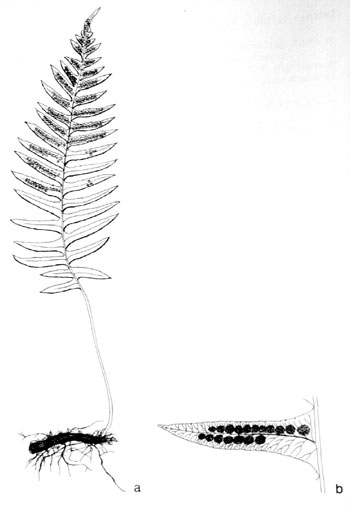| Polypodium glycyrrhiza | ||
Licorice fern | ||
|
Etymology
Glycyrrhiza comes from the Greek glykys meaning sweet + rhiza a root. The rhizome is licorice flavored. The licorice of commerce comes from Glycyrrhiza glabra, a flowering plant.
Description
Rhizome: creeping, branching, not whitish waxy, slender to moderately stout, to 6 mm diameter, sweet, licorice flavored, scales lanceolate, brown or slightly darker near point of attachment.
Frond: 75 cm high by 16 cm wide, evergreen, monomorphic, blade/stipe ratio: 2:1. Stipe: jointed at base, straw-colored, glabrous or scattered with thin light-brown scales, vascular bundles: 3. Blade: pinnatifid, lanceolate, usually widest near middle, occasionally at or near base, herbaceous, rachis downy above, a diagnostic feature, also on the pinna midrib (costa). Pinnae: 10 to 20 pair, linear with a long-acuminate tip, to 8 cm, is the most common form, but rounder tips also found; margins finely serrate or crenate; veins free. Sori: round or sometimes oval when immature, discrete, less than 3 mm diam, midway between margin and midrib to nearly marginal; on all but the lowest pinnae of fertile fronds, indusium: absent, sporangia: yellow to brown at maturity; paraphyses absent, maturity: late fall to spring. Culture
Habitat: cliffs and rocky slopes along coasts, often epiphytic.
Distribution: Kamchatka, north to the Aleutians, south to California, disjunct in Idaho.
Hardy to -25�C, USDA Zone 5.
Distinctive Characteristics
Hairs on the upper side of the rachis are a unique character; no diagnostic photo could be found. P. hesperium is reported as having variable-tasting, but sometimes sweet-tasting rhizomes. P. glycyrrhiza is generally a larger plant than the other two listed western North American species, but this is not a completely reliable character. So, too, with the long-pointed pinnae; when present they are likely diagnostic, but shorter, more rounded apices are also reported.
Synonyms
Polypodium aleuticum A. E. Bobrov Polypodium falcatum Kellogg Polypodium occidentale (Hooker) Maxon Polypodium vulgare Linnaeus subsp. occidentale (Hooker) Hult�n Polypodium vulgare var. falcatum (Kellogg) H. Christ Polypodium vulgare var. occidentale Hooker Compare with other species in the Western North America Group
|
|
|
